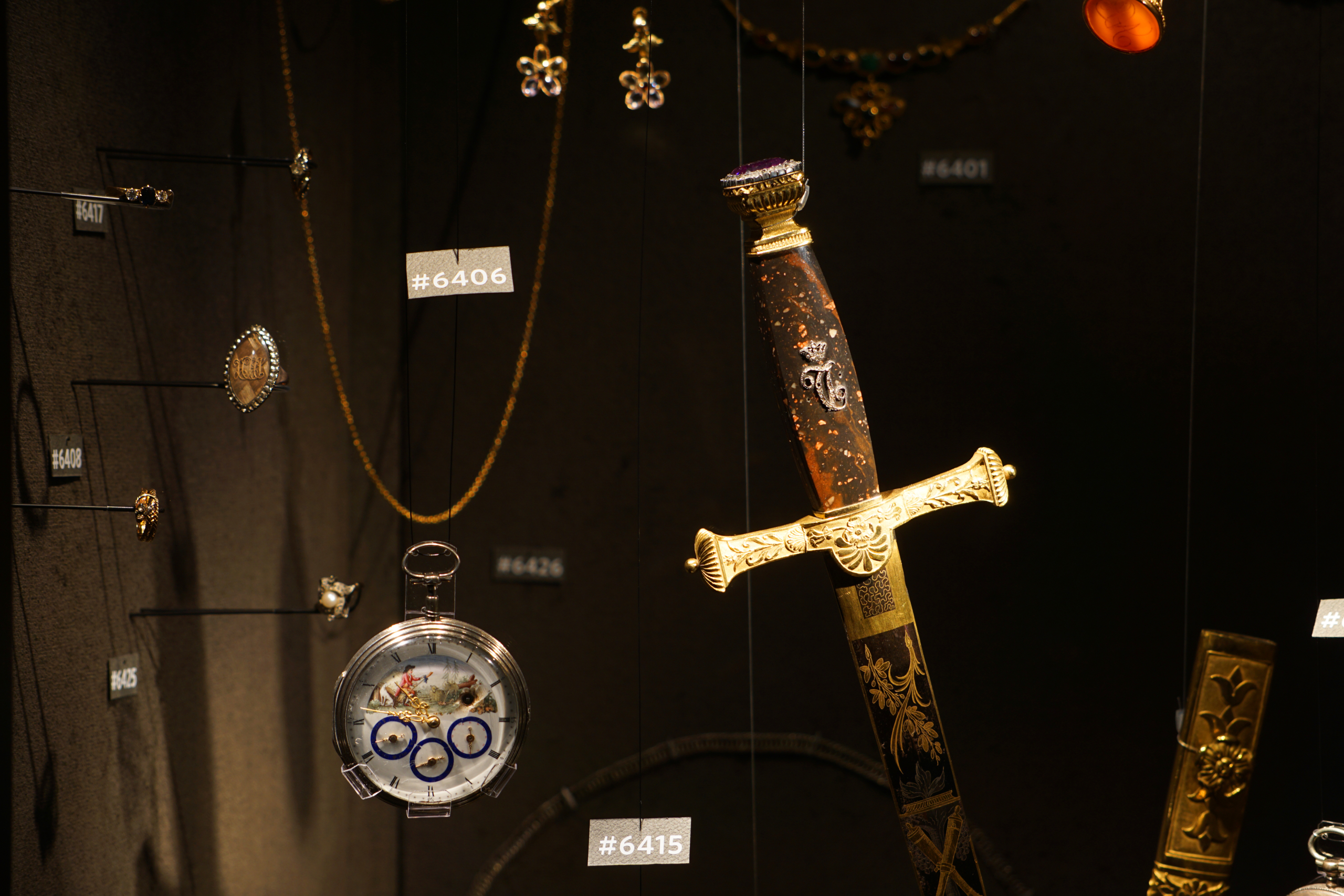
Expensive jewellery has been a way for people to collect their assets instead of putting money in the bank. The jewellery became a kind of insurance. The objects could be sold when times were tough or taken along if someone was forced to flee – and this is still true today.
Showing off their jewellery is also a way for people to demonstrate their wealth. As a result, it has always been common to have copies of basic-quality jewellery and watches. But even cheaper materials such as rhinestones, an artificial replacement for diamonds, can be modern and give status if the right person wears them. In the 1700s rhinestones were popular at the French court.
Monetary or economic value refers to the price something costs at the time it is for sale. Monetary value changes depending on supply and demand – how much is for sale and how many people want to buy it. Diamonds and jewels have had high monetary value over time.
Jewellery can symbolise important events in life or family ties, and therefore also gain a sentimental value. To be able to keep an object of monetary value for emotional reasons is a luxury that many people can’t afford.
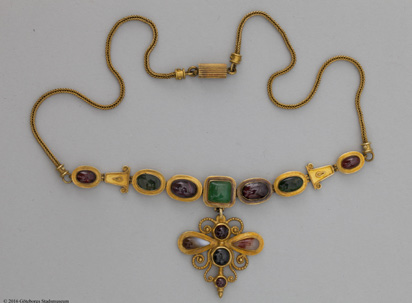
6401
Gold necklace
A necklace made of gold with 12 stones of different colours. Seven stones hang in a row and under them is a pendant with another five stones. The necklace was made in about 1850 and is 42.5 cm long.
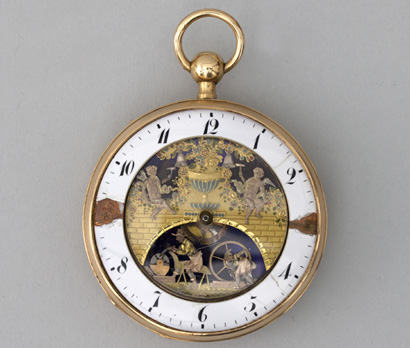
6402
Pocket watch
with angels
A pocket watch made of gold and enamel. It was made in the beginning of the 1800s. In the middle of the watch is a painting of angels and people working. The watch face is white. It is damaged beside the numbers three and nine. The watch is 6 cm in diameter and weighs 136 grams.

6403
Sword
A gilt sword with a double-edged blade. The sword pommel is square with a small purple amethyst surrounded by rose-cut diamonds. The hilt is made of bronze. On the sword are tendrils of oak leaves, palm branches, weapons and trophies. The sword is from 1821. It is stored in a sheath of black leather with gilt mountings. The sword is 93.6 cm long.
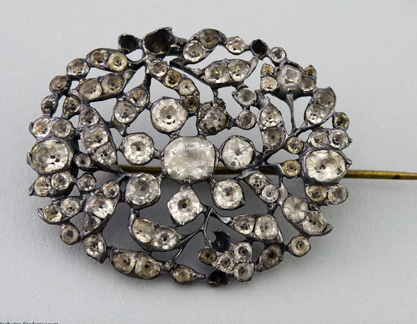
6404
Rhinestone brooch with rock crystals
A rhinestone brooch made of silver. It is decorated with rock crystals made to look like diamonds. The brooch was probably made in the second half of the 1700s. It is 3.5 cm in diameter and designed to look like foliage. On the back is a brass pin to attach the brooch with.
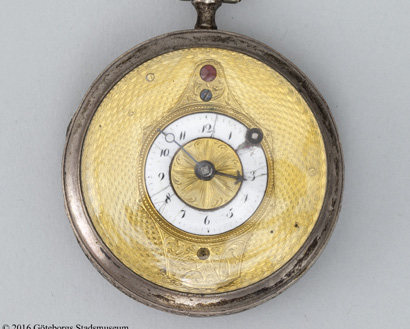
6405
Pocket watch
with gilt silver
A pocket watch with a silver case. The ring of numbers is made of white enamel and the watch face of gilt silver. Inside the watch is a red ruby above the number 12. The pocket watch is from the later 1700s. It is 5.3 cm in diameter and weighs 103 grams.
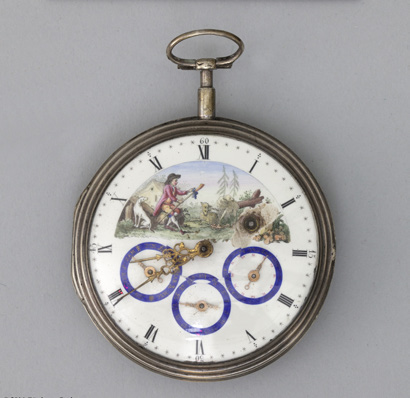
6406
Pocket watch
with shepherd
A pocket watch made of silver with a white enamel face. In the upper half is a painting of a shepherd holding a crook with a light-blue bow. He has a dog beside him and two sheep in front of him. They are standing in a green landscape.
On the lower half of the watch are three blue rings with hands for the day, date and month. The pocket watch is from the later 1700s. It is 6.6 cm in diameter and weighs 134 grams.
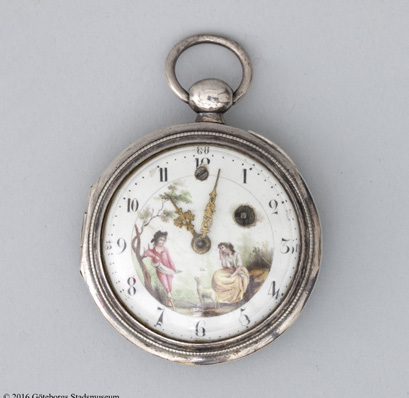
6407
Pocket watch with gentleman and lady
A pocket watch made of silver with a white enamel face and gilt hands. On the watch face is a painting of a man in a black hat, pink suit and white cape. He is leaning against a tree. On the right sits a lady dressed in white and yellow. Between them stands a white lamb. On the back of the watch is an engraved landscape with a church. The pocket watch is from the later 1700s. It is 4.8 cm in diameter and weighs 80 grams.

6408
Ring with
hair work
A gold ring. It is oval with pointed ends and is decorated with woven hair. In the middle is a monogram and around the edge are rock crystals. The ring was made during the first part of the 1800s. It is 3.2 cm high and 2 cm wide.

6409
Seal stamp
of silver
A seal stamp made of silver. It has a decorated handle and a stamp made of rock crystal. The stamp face has engraved images on three sides, which can be turned so they are in the correct position. On the sides are the text J.H.L., a coat of arms, and an emblem with the text “TOUIOURSAINSI”, which means “Ever thus” in French. The stamp was made at the end of the 1700s. It is 5 cm high.
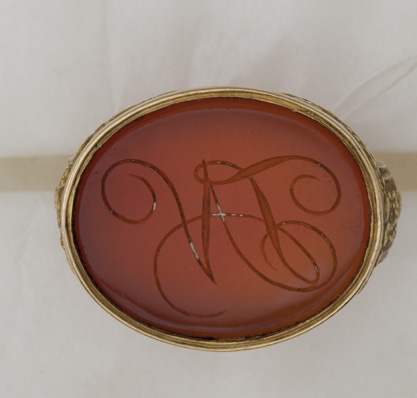
6410
Seal stamp
of gold
A seal stamp made of gold. The stamp face is orange brown in colour and is made of the semi-precious stone carnelian. On the face are the initials “N.L.” The stamp was made in the beginning of the 1800s. It is 3.3 cm high and 3.5 cm wide.
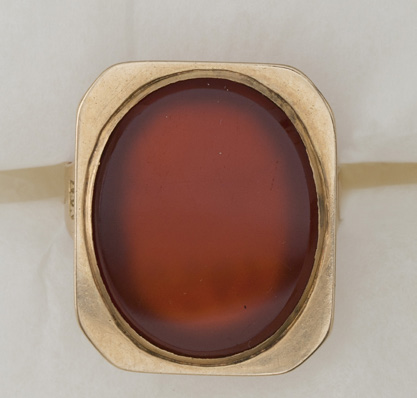
6411
Man’s gold ring
A man’s gold ring. It has a large oval orange-brown stone made of carnelian. This type of ring is usually engraved with a pattern or name so it could be used as a seal but this particular ring has no such engraving. The ring was made in Stockholm in 1819. It is 2.5 x 2.6 cm.
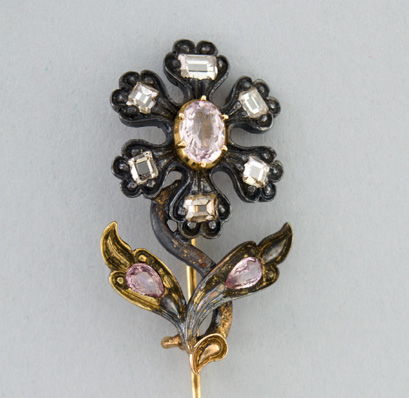
6412
Flower-shaped
ruffle pin
A ruffle pin in the form of a flower. A ruffle pin was used to hold together a ruffle around the neck. A ruffle is a pleated and often starched strip of fabric. On the stem of the flower are two gold and silver leaves decorated with diamonds. The pin was made at the end of the 1800s and belonged to Joseph Czapek, a music director in Göteborg. The pin is 3.4 cm high and 1.9 cm wide.

6413
Queen Sophia’s ruffle pin
A ruffle pin made of gold. It has a large red stone in the middle at the top. Around the large stone are small white stones. A ruffle pin was used to hold together a ruffle around the neck. A ruffle is a pleated and often starched strip of fabric. This pin was based on a drawing by Queen Sophia. King Oscar II gave it to music director Joseph Czapek, who had earlier set to music a poem written by the King.
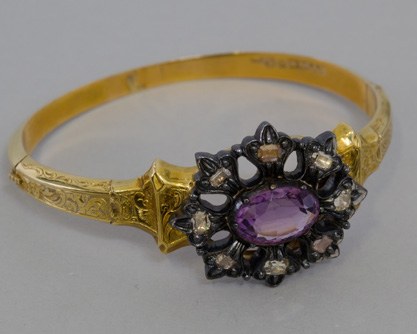
6414
Gold bracelet
A gold bangle. The top section has an engraved pattern and in the centre at the top is a purple amethyst. Around it are white stones made of rock crystal in the shape of a star. The ring was made in 1848.

6415
Gold charm
A small round gold charm. A charm is an ornament made to be attached to another piece of jewellery. One side of the charm has the text “Fidélité” in enamel. Fidélité is French for loyalty. On the other side is a wild pansy in enamel. Under the charm hangs a key with a heart on each side. The charm is 1.4 cm in diameter and 3.2 cm high including the hanging attachments.
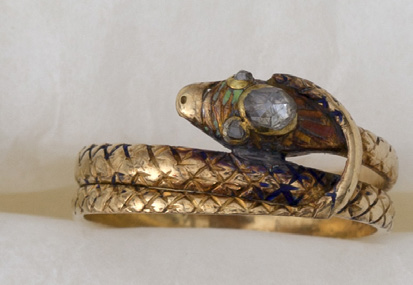
6416
Snake ring in gold
A gold ring that looks like a snake. The snake’s tail crosses its head at the front of the ring. The snake has eyes of white stones and a larger white stone in the centre of its forehead. The ring was made in 1830.
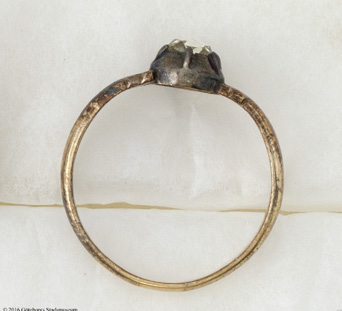
6417
Gold ring with
rose-cut diamonds
A thin gold ring from the 1800s. At the top of the ring is a rose-cut diamond.
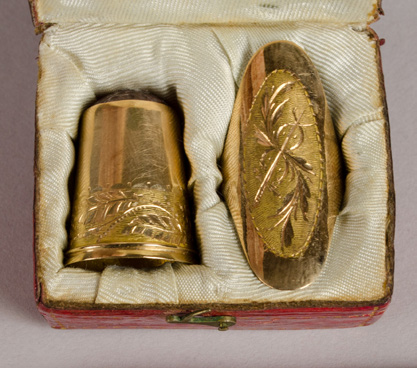
6418
Gold thimble
The thimble is made of 18 carat gold and decorated with a pattern. It is red on the top. The thimble is in a red leather box together with a patterned gold finger guard. The box has white fabric inside and a gold pattern stamped on the top. The box is stamped with the City of Gothenburg stamp and the hallmark for 1837. It is 3.5 x 4.2 cm.
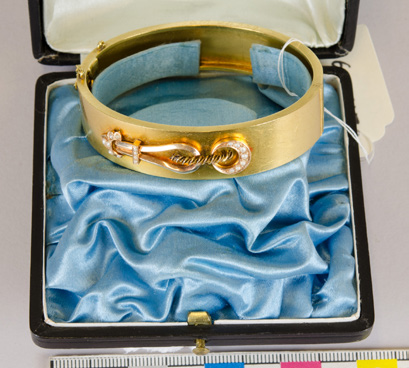
6419
Gold bracelet with pearls
A gold bangle. The bangle is smooth and is 1.4 cm wide. On the top it is decorated with a gold relief pattern and small white pearls. The bangle is on a bed of light-blue silk in a black leather box.
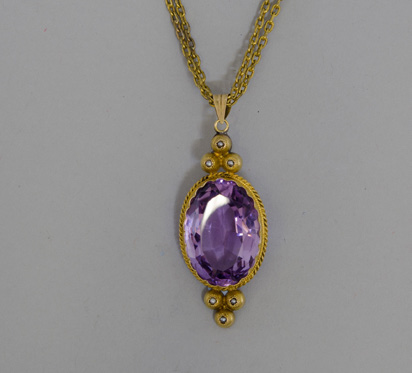
6420
Gold necklace with amethyst
A necklace with a pendant. The pendant is gold plated. The pendant is set with an oval purple amethyst. Above and below the amethyst are three small white pearls. The double chain is made of gold. It is 132 cm long.
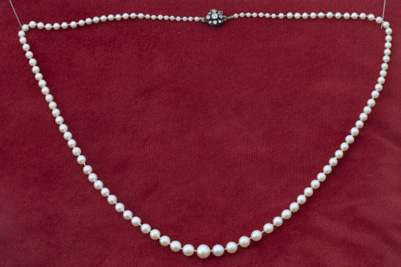
6421
Pearl necklace
The necklace is made of cultured pearls. It has a silver clasp set with cut glass stones. It is 61 cm long.
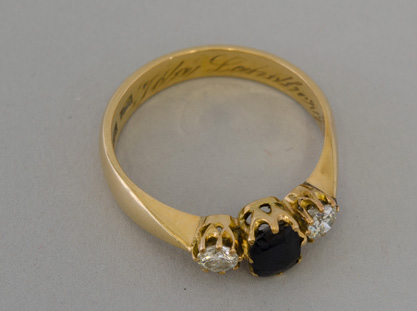
6422
Gold ring with sapphire
A gold ring with a blue sapphire. The sapphire is flanked by two white brilliant-cut diamonds. The ring was made in 1875.
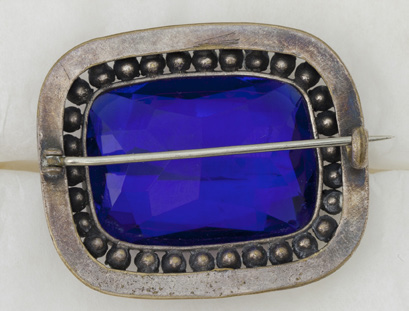
6423
Fake brooch
A brooch with a blue stone. It is made of silver-plated metal, and is therefore “fake”. In the middle is a blue stone surrounded by 30 small white stones. On the back is a pin to fasten the brooch with. The brooch is 3.5 cm wide and 4.2 cm high.

6424
Earrings in yellow and red gold
The earrings are shaped like three leaves with a flower under them. The flower’s petals are made of semi-precious stones, with three pale yellow citrines above and two pale purple amethysts below. The flower’s centre is a round red garnet. The earrings are 3.7 high and 2 cm wide.
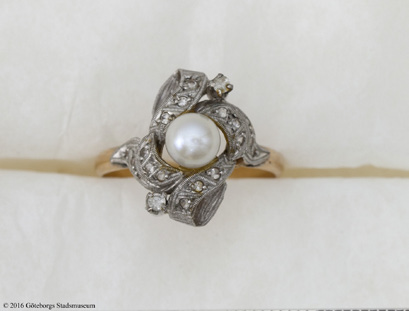
6425
Gold ring with pearl
The ornamentation on the top of the ring is shaped like a rosette. The ring is probably made of white gold and has small white artificial stones. In the middle is a white pearl.
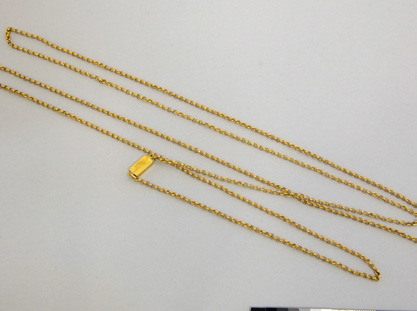
6426
Gold watch chain
A watch chain made of gold. The style of the round links in the chain is called “pea chain”. Several chains are held together by a flat clasp. The chain was probably made at the beginning of the 1800s. It also appears to have been used as a necklace, when it would have been wrapped several times around the wearer’s neck. It is 39.5 cm long. Accompanying the chain is a small round white box. According to a note on the box, the chain was lost in 1812 and found again 55 years later.
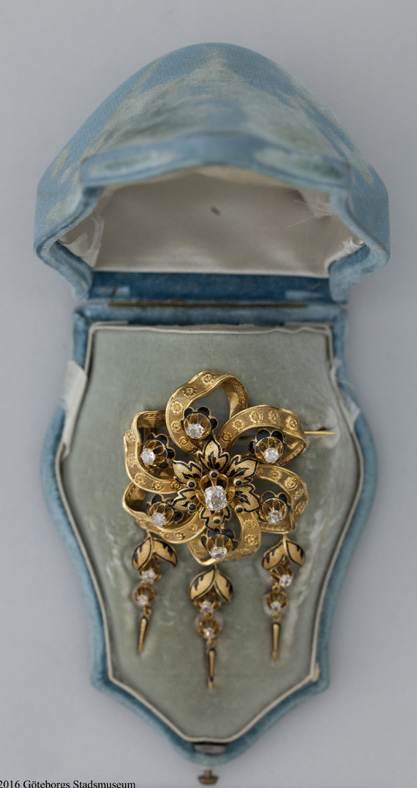
6427
Gold brooch
A brooch in gold, brilliant-cut diamonds and black enamel. The brooch was made in about 1850 and is in the Neo-Rococo style. It looks like a multi-ribboned rosette. A white brilliant-cut diamond sits in every loop. In the centre is a highly detailed flower with petals. Underneath are three pendants with brilliant-cut diamonds and gold leaves. The brooch is 4.3 wide and 7 cm high. The brooch comes with a custom box covered with light-blue velvet and partially lined with silk.
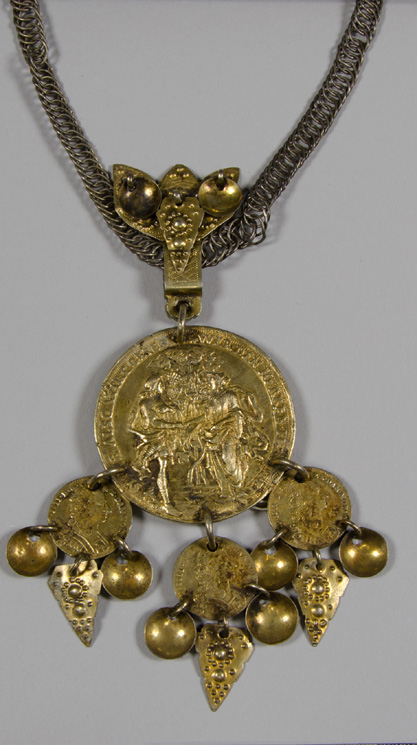
6428
Coin pendant
A pendant made of decorated coins and a silver neck chain. This pendant was called a “penningkors” (penny cross) in Swedish because the coins are assembled into the shape of a cross. The pendant is silver plate. Underneath a round medal hang three smaller skilling coins. The coins date from 1729. From each of the coins hang a leaf and two small balls. The large central medal is probably German. On the obverse (front) are a man and a woman holding hands. On the reverse at the top is a symbol of the Christian God; underneath that are two hands holding a heart and at the bottom are two turtle doves on a branch.